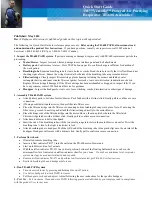
18
TIME DELAY CONTROL (TDC)
The time delay (TDC) is in the low voltage control circuit. When the compressor
shuts off due to a power failure or thermostat operation, this control keeps it off at
least 5 minutes which allows the system pressure to equalize, thus not damaging
the compressor or blower fuses on start-up.
HIGH PRESSURE CONTROL (HPC)
The high pressure control (HPC) keeps the compressor from operating in pressure
ranges, which can cause damage to the compressor. This is an auto-reset control
that opens near 450 PSIG and closes once the system pressure drops below 270
PSIG.
The high pressure control is wired in the 24VAC side of the control circuitry.
LOW PRESSURE CONTROL (LPC)
The low pressure control (LPC) keeps the compressor from operating in pressure
ranges that can cause damage to the compressor. This is an auto-reset control
that opens near 15 PSIG and closes once the system pressure rises above 40
PSIG.
The low pressure control is wired in the common side of the control circuitry.
THERMOSTAT USAGE WITH THE (-)ARL-/(-)ASL-
SERIES OF CONDENSING UNITS
A two-stage cooling thermostat is required for proper unit operation.
In applications where additional latent removal (dehumidification) is required or
desired, Rheem recommends the use of the White-Rodgers 90-Series thermostat
(model 1F95-CA397). On-demand dehumidification is capable when combined with pre-
mium ECM indoor products. This thermostat provides the following functionality when
connected to the (-)ARL/(-)ASL-series of condensing units.
• Humidity input to the indoor air handler or furnace via the “DHM” terminal on the ther-
mostat. Refer to System wiring for proper connections.
• Compressor protection via the L terminal when the Comfort-Alert module on the
condensing unit is connected to the L terminal on the thermostat.
COMFORT ALERT
The (-)ARL and (-)ASL condensing units are equipped with a Comfort Alert™ diagnos-
tics module. By monitoring and analyzing data from the Copeland Scroll® compressor
and the thermostat demand, the module can accurately detect the cause of electrical
and system related failures without any external sensors. A flashing LED indicator com-
municates the ALERT code and guides the service technician more quickly and accu-
rately to the root cause of a problem.
FIGURE 5
WHITE-RODGERS 90-SERIES THERMOSTAT
FIGURE 6
Содержание ARL Series
Страница 28: ...28 FIGURE 8 ARL 024 ARL 036 ARL 048 WIRING DIAGRAM ...
Страница 29: ...29 FIGURE 9 ASL 036 WIRING DIAGRAM ...
Страница 30: ...30 FIGURE 10 ARL 060 WIRING DIAGRAM ...
Страница 31: ...31 ...
Страница 32: ...32 CM 1005 ...















































